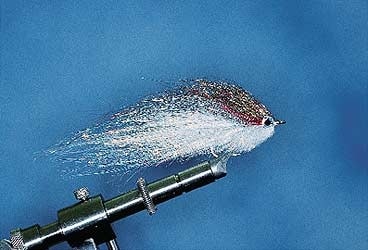
During mid-summer along the New Jersey shore, millions of juvenile menhaden take up residence within our back bays and tidal creeks. As fall breezes bring a chill to the air, these juveniles begin to mature into peanut bunker and pour out of the back bays and inlets to start their annual journey south along the northeast coastline. These peanuts range in size from 3 to 6 inches and carry with them a broad and flashy profile. Fly fishing during these massive migrations can be an extremely exciting experience and offers the fly fisher tremendous opportunities to hook into stripers, bluefish, false albacore and weakfish of trophy proportions. Unfortunately, with literally thousands of natural baits prevalent, predators can become extremely picky and refuse anything but the real thing. It was for this reason that I began to develop a fly that could closely match the color, length and profile of the peanut bunker and yet still remain significantly different by possessing some type of characteristic predators would be drawn to. The answer was a new flashy material called Angel Hair. Approximately four years ago, Anglers Choice introduced Angel Hair. At first, I began using the material as flash accents in our everyday popular fly patterns. Then I began blending the Angel Hair with other synthetic materials. It was at that time that I decided to construct a larger-profiled fly made exclusively of Angel Hair to use during the annual peanut bunker migration. A few days later I tested the fly in my home waters of Island Beach State Park, New Jersey, and was amazed at the success it brought. When the fly hit the water it lit up like a Christmas tree, reflecting light from every possible angle. When retrieved, the fly performed a snakelike movement through the water different from any other material I had seen. The faster the fly was stripped, the more movement it had. Just as I was about to lift up for my first real cast, a 30-inch striped bass inhaled the fly. Over the next few hours I caught a number of striped bass and false albacore on the Baby Angel. Although the fly caught fish, there were still problems with the design that I felt needed rectifying. The material around the belly of the hook fouled. By trimming the fly with scissors under the belly and on top of the back, that problem was solved. As a bonus, the width and profile better matched the natural bait.A few days later I went back out, and the changes worked. The fly was literally foul free, and still got devoured in the presence of hundreds of naturals. From that day on I was convinced that Angel Hair was a unique and special new material that attracted game fish like no other. In addition to striped bass and false albacore, the Baby Angel has also proven itself with weakfish, bonito, bluefish, fluke, yellowfin tuna, bluefin tuna and even albacore on the West Coast. I began to use the fly on my charters, handed out a few dozen to the locals, and continued to see a growing success rate with all of the species here in the Northeast. Larry Holzenthaler, of Atlantic Saltwater Fly Rodders, took the fly with him this winter on a long-range tuna trip south of Point Loma, California. During an all-out surface blitz, Larry took numerous yellowfin and albacore tuna between 20 and 30 pounds when they would not touch any other fly pattern. When fishing the Baby Angel, I prefer a slow to moderate retrieve for stripers and weakfish. For the tunas, however, a faster, more erratic retrieve seems to prove more productive. The Baby Angel can be tied in lengths anywhere from 2 to 8 inches long in a variety of colors and shapes. The fly’s design does not have to be limited to wider-profile baits. Incorporating the same tying and trimming methods can create any minnow-shaped baitfish with ease.When tying the Baby Angel, it is important to use a few basic tying methods. Each length of material should be pulled directly from the main bundle of Angel Hair. Every step in tying the Baby Angel starts by securing the middle of the material to the hook first. Therefore, if you want the tail to extend 3 inches past the hook shank, pull a 6-inch clump of Angel Hair. Spinning the material in opposite directions with your fingers before it is secured will make it easier to control. Create the length of your fly by tying the tail at the bend of the hook shank. Once the tail is built, each step will simply repeat itself using shorter lengths of material in order to create the fly’s profile. By folding over the material in successive ties, the profile is built up quickly, giving it the wider look of a menhaden. This will create a clean taper to the material and eliminate waste when it comes time to trim. Trimming the excess material under the hook shank and on top of the back will enhance the fly’s realistic appearance and eliminate fouling.









